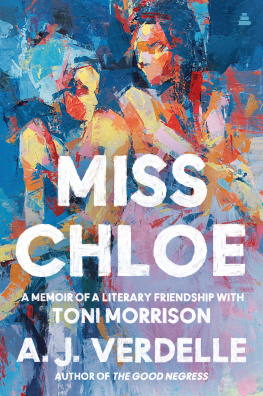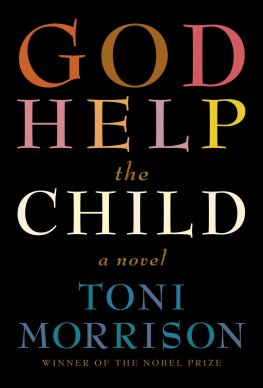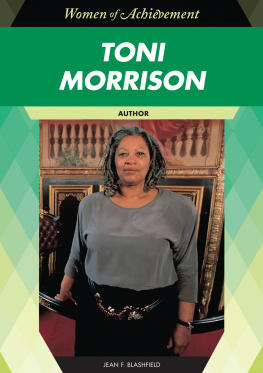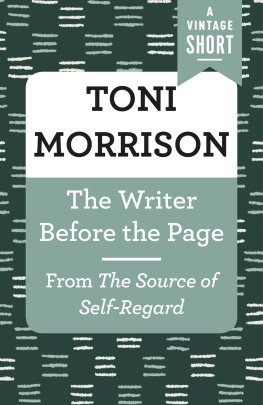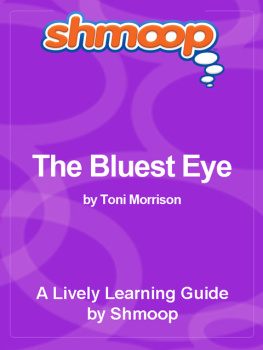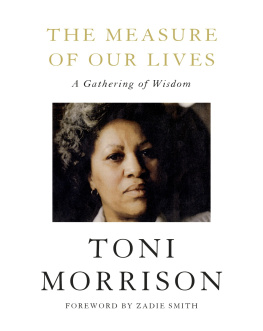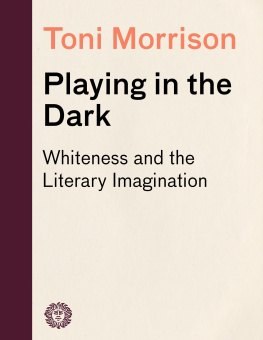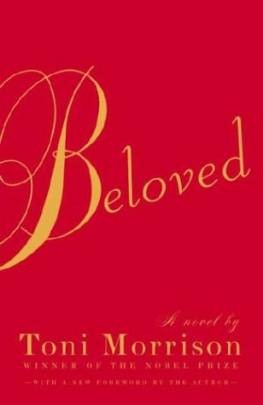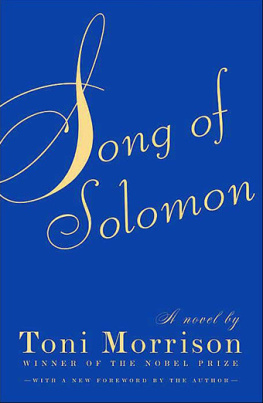We are each others harvest:
We are each others business:
We are each others magnitude and bond.
Gwendolyn Brooks
from the poem Paul Robeson
Contents
W hen you open the door to Toni Morrison, you look genius in the face. She was a legend while she lived. Now that shes gone, shes a literary monument. A beacon. An ancestor. An everlasting eidolon, thriving in a weightless world. A woman and a writer who left a voluminous legacy. A woman who lived through incarnations we can only conjure. Consider:
Chloe Ardelia Wofford was born colored, in Lorain, Ohio, in 1931.
Colored was the term of the time. Colored is what her birth certificate says. Mine says negro. Morrison was twenty-nine when I was born. So, in those three decades, we made our first naming transition. Officially. From colored to lowercase negro. More name changes have come, as we stopped accepting definition solely as a racialized opposite.
Toni Morrison lived a dozen years short of a century, but she researched, thought about, and reimagined all four centuries of our experience here in this country we call America. This little girl from Lorain made books covering all our eras. She focused on our positions under the low sky of our lives: first as colored, which was originally an emancipated moniker; then as negro; then as Negro; then as black; then as Black; then as African Americanwhich brings us, through self-definition, to now. Her books about usabout people living under unseemly, outrageous, and callous conditionsmanaged to capture our persistence and stamina and aliveness, regardless of how our country left our future for dead. Written from inside our culture, her characters and their struggles ring true to our experience, even when her invented scenes or situations were improbable or impossible.
Morrisons works are soaring, towering accomplishments. Some of her sentences vault high as church steeples; her word choices ring with musicality; her constructed scenes or chosen names can give you pause. In Beloved, Sethes dog is named Hereboy, which is canny and a linguistic reference at once. Through her characters and their situations, Morrison considered multiple positions; her works start and settle debates. People become seriously motivated after reading Toni Morrison; I have seen folk take definite action, in their own best interest, as a result of a Toni Morrison book. I read an article about a successful African American businesswoman who read a Toni Morrison book and then took the leap into entrepreneurship. People everywhere are changed after reading Toni Morrison. Though Morrison credited everyone with their own choices, that her works were transformative did not escape her and did not displease her.
C HLOE W OFFORD MADE T ONI M ORRISON of herself. She pursued the highest heights, throughout the arc of her experiencestaring, glaring, working, peering, writing, imagining. Pencil in hand, she watched her country writhe, be vile, throw up waves of consistent and insistently revived ignorance and hatred. She herself defied derision. She refused to be a victim. This refusal was part of what set her free. Toni Morrisons intense attention to her talent, her genius, set her mind aloftand set her work a-sail in the free air. Morrison famously pronounced racism a distraction. A system that forces people to argue about their value or viability, as opposed to focusing on their own lives, their own gifts, their own hopes. Racism sucks energy from human development. Rather than succumb to the distraction of responding to what others thought she, or we, could not be, Toni Morrison refused to race-splain. Why argue our humanity to obstinate people who are, at their most benign, terrifically unaware? Toni Morrison spent her time on earth being and becoming and developing who she was, which was genius.
Not everyone who faces racism is unvictimized or, like Morrison, unvictimizable. Not everyone can make that decision. You have to have some chops, some cash, some wherewithal, to refuse, as she describes it. One of Toni Morrisons key positions was that you work with what you have. She had the goods.
Unchecked greed and ruthless oppression combined to deny our presence, our humanity, our capability, and our accomplishments, but Morrison understood these behaviors to be unjustifiable and patently ridiculous, if at the same time painful. She chose consistently to lean into her own legacy, to cultivate her own confidence, to live in the landscape defined by the truth of her strengths, including language, including the strength of her culture.
A S A YOUNG B LACK GIRL in America, I was already in Morrisons debt. This I was aware of. Morrison belongs to a rare club of writers who have changed literature, popular culture, and Black womens views of themselveslike Zora Neale Hurston, Maya Angelou, Paule Marshall, June Jordan. Women and readers of this time, of this era, will elect the changemakers of their time. During her era and mine, Morrison accomplished an enormous tour de force: by relentlessly stripping the hegemonic gaze, Morrison made us and our human complexities so visible, in language so eloquent and deep, that the whole of world literature could not deny her innovation and brilliance. When I met Toni Morrison in person, I had been her reader and her cheerleader for dozens of years.
Morrisons fame is far-reaching. You can find Toni Morrison quoted here, there, and everywhere. Translations abound. YouTube has scrolls of clips of her. There are articles galore. There are hundreds of published interviews. She talked about writing, she talked about race, she talked about racism, she talked about motherhood, she talked about history and social justice, about who had the problems and what were the salient questions. Her commentary tended to be targeted. Her narratives created characters we can call by their first names, and can remember, and can quote. In some circles, Toni Morrison quotes are flung about like Frisbees. If you have readers in your life, it might take you twelve minutes to find somebody who can quote Baby Suggss Sermon in the Field. Some folk can quote Joe Trace sitting around sorry after he murders his little girlfriend. Women can quote Sula and Nel, BFFs whose luck with each other runs outsort of. Other women can tell you when they are a mans third beer.
For some of us, Morrison evoked mighty changes in our vision, by her work and her writing and her piercing, unrelenting insight. Her writing covered innumerable facets of our livesso many that were her books brilliant gemstones, the carats would be uncountable.
Toni Morrisons oeuvre is still shimmering. Her books are time-centered and timeless simultaneously. Though some of her books are more than forty years old, they read as contemporary. Her narratives contain generations that invoke whole swathes of our culture, if not its generalized totality. Her willingness to reach across time and age met no limits in chronology. Most of what we think about, worry over, consider, ponder, wrestle with today, decades into the twenty-first century, Morrison has covered, in one book or anotherset at whichever time in our long chronology of yesterday she happened to be staring down. Her subjects reference theories of life, and philosophy, and violence, and Black people, and our interiors. Her narrative crises magnify our social and familial challengeswhich have not let up for centuries. Morrison reimagined a history that only our ancestors have lived. Morrisons novels are specific and sweeping and rattling; her works are read and read again.
We reference her narratives by those moments that shook us. And there are plenteous moments to be shaken by, to choose from. Her ideas are debated and argued over, written about and reifiedin colleges and universities all across this nation and the world. I know this. I teach college students. I teach graduate students. I meet and speak to students and writers from all corners. Morrisons work is studied and parsed in multiple languages and in an array of disciplines. Literature first. But also history, sociology, womens studies, magic/occult, religion, Black womens studies, Black/African American studies, American studies, rhetoric, architecture, civics, the history of cities.

